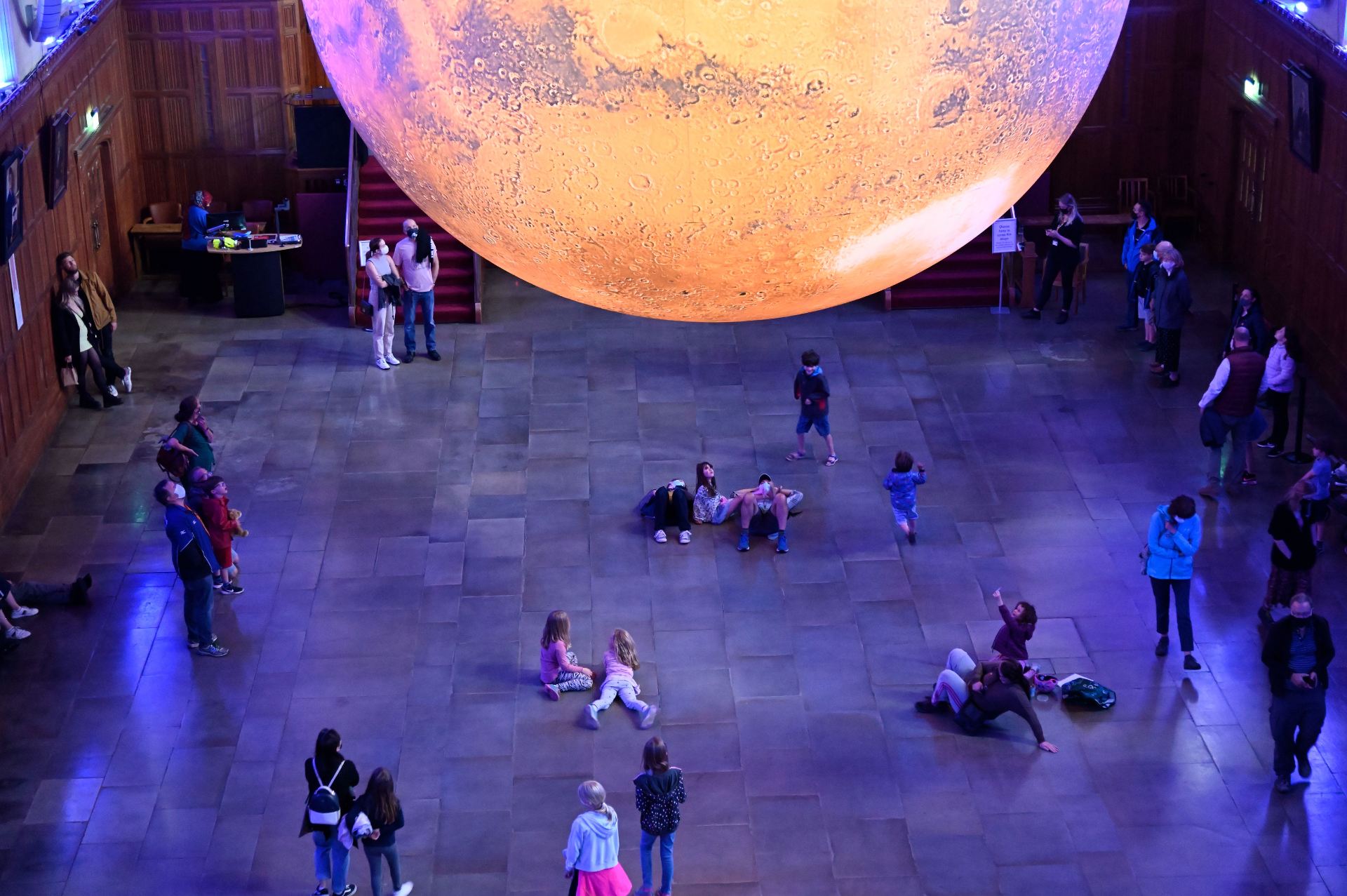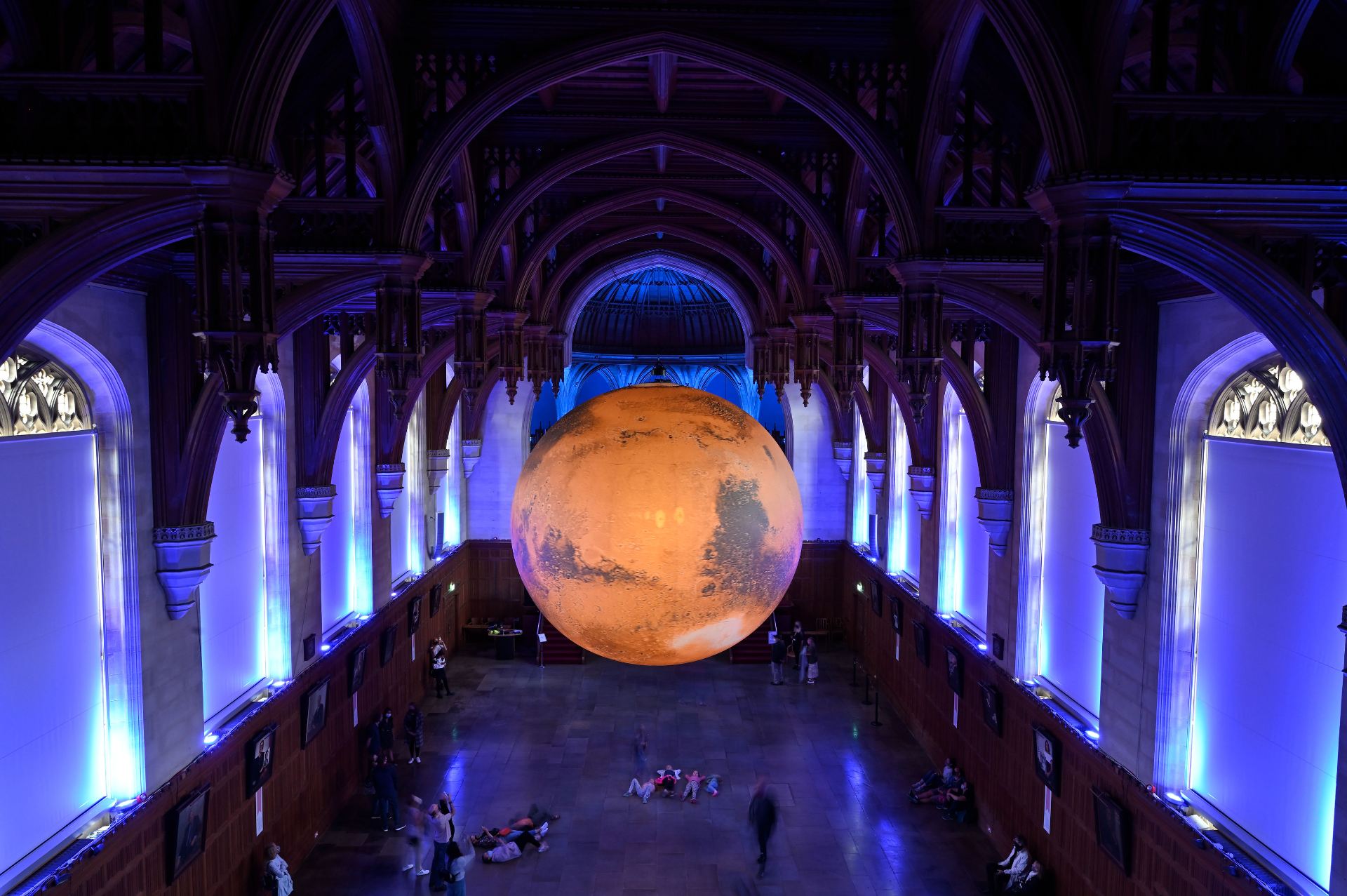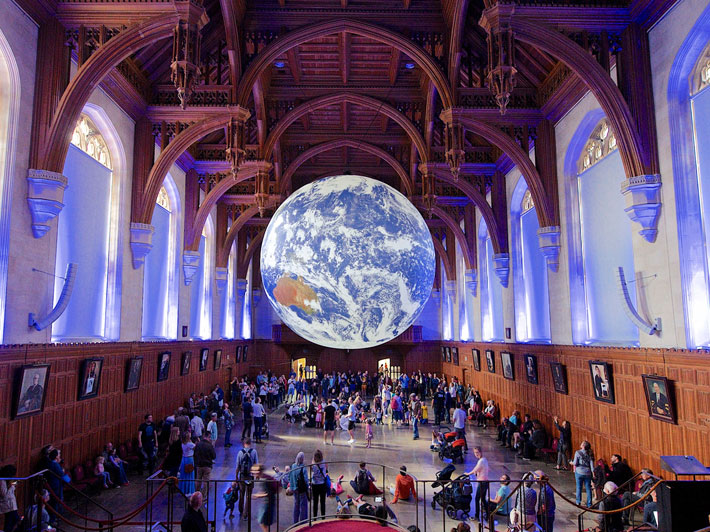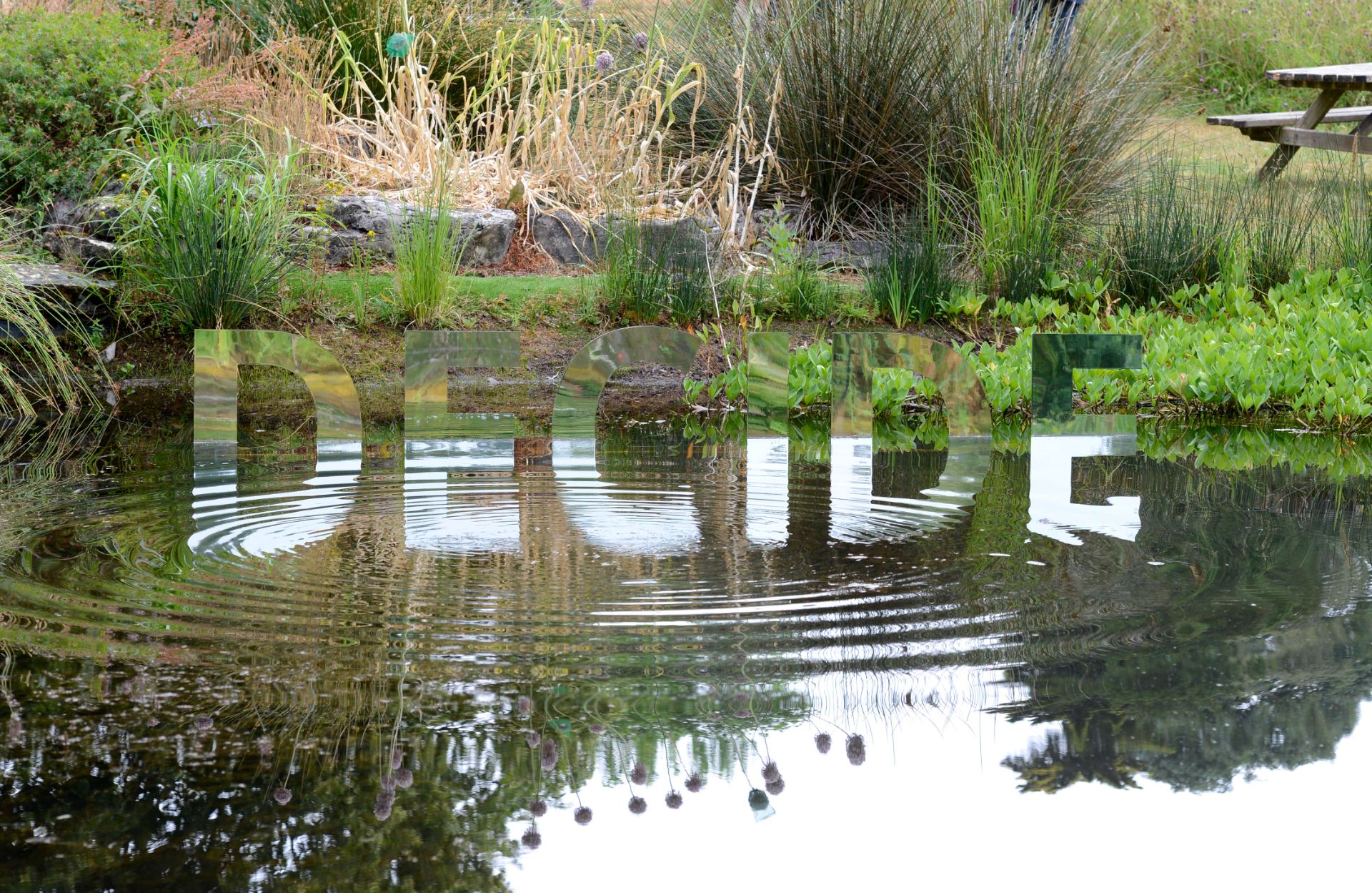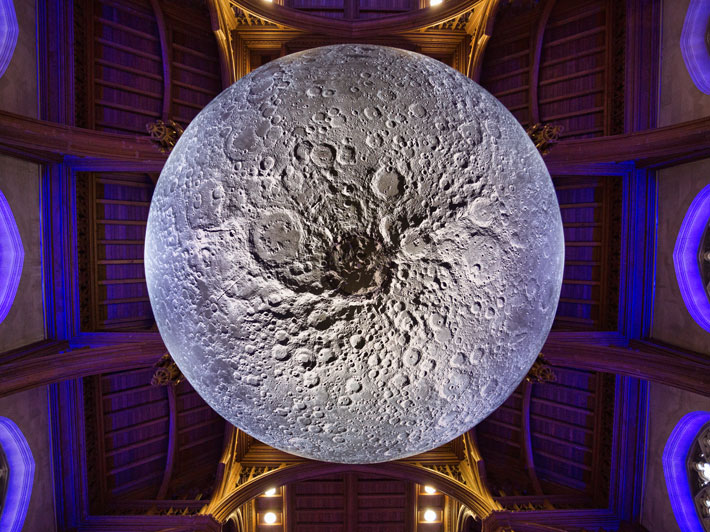Bristol-based Luke Jerram‘s multidisciplinary arts practice involves the creation of sculptures, installations and live artworks. Jerram received an honorary degree from the University of Bristol in 2020 and has collaborated with the University on a number of projects.
Mars (2021)
Luke Jerram’s Mars was exhibited in the Great Hall of the Wills Memorial Building in August 2021. Measuring seven metres in diameter, the artwork features 120dpi detailed imagery of the Martian surface, compiled from Visible Earth series, NASA. At an approximate scale of 1:1million, each centimetre of the spherical sculpture represents 10 kilometres of the surface of Mars.
This will be the first time I’ll have presented Mars slowly revolving, so I’m excited to see how this movement gives life to the sculpture. It’s a great pleasure to bring this new work to Bristol and the Great Hall of the Wills Building is such a great venue. I’m sure all the geologists and astronomers at the University will be excited to see Mars up close.
This artwork, which is now touring, allows us to view Mars from the air and transports us to its desert wasteland. Every valley, crater, volcano and mountain is laid bare for us to inspect, Providing an opportunity to study the surface in perfect detail and imagine what it’s like to step foot on this incredible planet.
Mars was co-commissioned by Kunsthal KAdE, Netherlands; UK Space Agency; Science and Technology Facilities Council, UK and UK Association for Science and Discovery Centres. With supporting partner University of Bristol, home of the Cabot Institute.
Multimedia experience
The installation is a fusion of Mars imagery, light and surround sound composition created by BAFTA and Ivor Novello award winning composer Dan Jones.
Gaia (2019)
Gaia was installed at the University in August 2019. The artwork is 1.8 million times smaller than the real Earth with each centimetre of the internally lit sculpture describing 18km of the Earth’s surface. By standing 211m away from the artwork, the public will be able to see the Earth as it appears from the moon.
Measuring seven metres in diameter, Gaia features 120dpi detailed imagery of the Earth’s surface, compiled from Visible Earth series, NASA. The artwork provided the opportunity to see our planet on this scale, floating in three-dimensions.
Unlike the moon, which we have been gazing at for millennia, the first time humankind got to see the Earth in its entirety as a blue marble floating in space was in 1972 with NASA’s Apollo 17 mission. At this moment, our perception and understanding of our planet changed forever. Hanging in the black emptiness of space the Earth seems isolated, a precious and fragile island of life. From a distance, the Earth is just a pale blue dot.
The installation creates a sense of the Overview Effect, which was first described by author Frank White in 1987. Common features of the experience for astronauts are a feeling of awe for the planet, a profound understanding of the interconnection of all life, and a renewed sense of responsibility for taking care of the environment. Watch this great film about the phenomenon.
A specially made surround sound composition by BAFTA award winning Composer Dan Jones is played alongside the sculpture. In Greek Mythology Gaia is the personification of the Earth.
Gaia has been created in partnership with the Natural Environment Research Council (NERC), Bluedot and the UK Association for Science and Discovery Centres.
The Impossible Garden (2018)
The Impossible Garden was a 2018 exhibition of experimental sculptures, by artist Luke Jerram, inspired by visual phenomena. It included 12 engaging art exhibits at the University’s Botanic Garden, designed to help promote understanding and stimulate debate about how visual impairments can affect our perception of the world around us.
The Impossible Garden came about after the artist’s nine-month residency at the Bristol Eye Hospital and Bristol Vision Institute (BVI), funded by the Leverhulme Trust.
Luke undertook the residency together with Cathy Williams, a member of BVI and a Consultant in Paediatric Ophthalmology at Bristol Eye Hospital.
As part of the residency, Luke worked with BVI researchers, Bristol Eye Hospital, Botanic Garden and spent time with visually-impaired children to increase his knowledge of visual perception.
The collaboration with Luke is a fantastic opportunity for us to explore the power of visual illusions. Understanding how they work can tell us a lot about the properties and limitations of our visual system.
This exhibition, created as a set of experimental sculptural artworks, has provided me with an opportunity to explore new optimal phenomena, test ideas and share my interest in visual perception with the public.
Museum of the Moon (2017)
The Museum of the Moon (2017) was exhibited in the Great Hall at University of Bristol to mark the installation of the University’s new Chancellor, Sir Paul Nurse and to also reflect and celebrate the astronomical research which the University carries out. Over the years there has been a variety of moon related research completed.
From the beginning of human history, the moon has acted as a ‘cultural mirror’ to our beliefs, understanding and ways of seeing. Over the centuries, the moon has been interpreted as a god and as a planet. It has been used as a timekeeper, calendar and to aid nighttime navigation.
Throughout history the moon has inspired artists, poets, scientists, writers and musicians the world over. Different cultures around the world have their own historical, cultural, scientific and religious relationships to the moon.
Museum of the Moon was co-commissioned by a number of creative organisations brought together by Luke Jerram and Norfolk & Norwich Festival. These include: Greenwich+Docklands International Festival, Brighton Festival, Without Walls, Cork Midsummer Festival, We The Curious, Lakes Alive, Provincial Domain Dommelhof, Les Tombées de la Nuit, Rennes and Kimmel Center for the Performing Arts.
The artwork has been created in partnership with the UK Space Agency, University of Bristol and The Association for Science and Discovery Centres.
Luke Jerram
Luke Jerram‘s multidisciplinary practice involves the creation of sculptures, installations and live arts projects. Living in Bristol but working internationally for 20 years, Jerram has created a number of extraordinary art projects which have excited and inspired people around the globe.
Impossible Garden Partners
Bristol Vision Institute
Bristol Vision Institute (BVI) is the home of vision science research in Bristol and has been successfully stimulating research interaction and collaboration in science, engineering, arts and medicine since its creation in 2008. It brings together some 170 associates from engineering, computer science, biological sciences, psychology, ophthalmology, history of art, film & television and medicine with the aim of addressing grand challenges in vision research.
University of Bristol Botanic Garden
The Botanic Garden has a strong evolutionary theme and cultivates over 5,000 plant species forming four core collections that illustrate plant evolution, plants from Mediterranean climates, useful plants (including Chinese and Western herb gardens) and rare and threatened native plants to the Bristol area.
About Bristol Eye Hospital
Bristol Eye Hospital is one of the country’s leading specialist hospitals with an international reputation for the treatment of diseases of the eye, and highly respected as a pioneer in research, education and clinical practice.
The hospital, run by University Hospitals Bristol NHS Foundation Trust, is supported by a wide range of staff including 29 consultant ophthalmologists, seven speciality doctors, optometrists, trainee doctors, clinical fellows, pharmacists and nurse practitioners.

